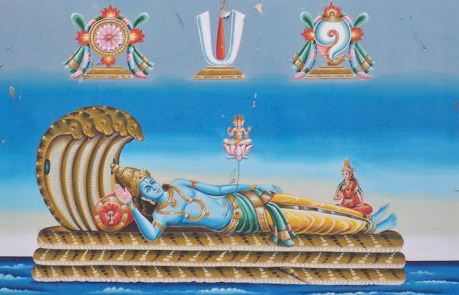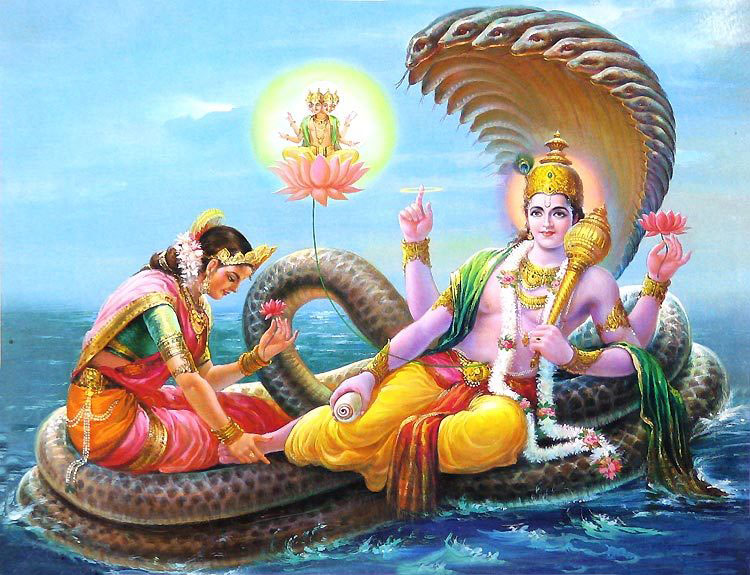Chapter 10
Time – span is different for man, God and Brahma. Time durations of various yugas also vary.
The Powers beyond cognition
Parasara replies: My son! Maitreya! How is it that you are the best among those engaged in tapasya? Though you have many identical qualities with others, how is it that you are richer in tapasya? How can I reply to such a question?
In the same way, each of the elements in this world has its own special properties. The power of one element cannot be found in another. Fire burns. Water is cool. Suppose one asks, why cannot the water be hot, why shouldn’t fire be cool, there can be no answer. The answer can only be that this is the law of nature.
Hence the properties of elements cannot be analyzed. One can only infer them from their effect.
Saktayassarvabhaavaanaam achintyajnaanagocharaah
According to this law, the Lord who is the Maker of this creation is quite different from the other makers. He is not bound by action nor is He affected by the resulting joy and sorrow. He pervades everything, always. He has neither love nor hate nor sattva, rajas or tamas. But He has all the powers He needs to create the universe.
Yathotho brahmanastaasthu sargaadyaah bhaavasakthayah
strength and action. For instance, Fire is one of the five gross elements. But it has the power to burn, a power that no other element has. Why so? Because this is the law of nature.
Bhavanti tapataam sreshta paavakasya yathoshnataa
The Supreme Lord, who is the Creator, is totally free from the drawbacks found in other makers. He creates by remaining as the Antaryami (In dwelling universal) of Brahma.
Life spans for Man, God and Brahma
Brahma decides the life-span of the living beings on earth. No one can stay beyond the days laid down by Him. Brahma has the privilege of thus deciding the life-span of people. He is beyond time. Many may be under the impression that Brahma holds the highest post in creation. But there is a limit even to his lifetime. He can live only for a certain number of years. Generally the veda-s speak of the life-span of man as one hundred years. But very few live for a century. However, Brahma has to live through the hundred years laid down for him.
 There are three types of time-spans: the time of man, of gods and of Brahma. The life of men is known as Manushyamaanam, that of gods is Devamaanam and the life of Brahma is known as Brahmamaanam.
There are three types of time-spans: the time of man, of gods and of Brahma. The life of men is known as Manushyamaanam, that of gods is Devamaanam and the life of Brahma is known as Brahmamaanam.
Of these, the life-span of Brahma is one hundred Brahmamaana years. It is known as Param. It is known so as it is much longer than that of others. This lifetime is divided into two halves and each is known as Paraardha.
By multiplying manushyamaanam several times we get devamaana and by multiplying devamaana several-fold we get to brahmamaana. The time taken for a wink is known as nimisha. Fifteen nimisha-s make one kaashthaa. Thirty kaashthaa-s make up a kalaa and thirty kalaa-s, a muhurtha. Thirty muhurtha-s make one day-time and one night. A day is made up of day-time and night time. Fifteen days form a paksha. There is sukla paksha and krishna paksha. Two paksha-s make one month. Six months form an ayanam-s. This again is of two kinds: dakshinaayanam and uttarayanam. Two ayanam-s make one year. This is the manushyamaana. Of these, dakshinaayana is the night of gods and uttarayana, their day-time. Counted thus, one year of manushyamaana is one day of gods. The same count holds good for devamaana. Twelve thousand years of gods make one Chaturyuga.
Time durations of Yugas
Of these, Kritayuga has four thousand years of gods, Tretaayuga has three thousand years of gods Dvapar yuga, two thousand years of Gods and Kaliyuga, has one thousand years of Gods. Thus a Chaturyuga holds ten thousand years of gods. The rest of the two thousand years of gods are the Sandhya (pre-yuga) and Sandhyamsa (post-yuga).
Pre-yuga time is Sandhya and post-yuga time is Sandhyamsa. The time in between is termed Yuga. The Yuga Dharma-s are formulated in these aeons. Each Yuga will have several thousand years of Gods and as many hundred years of Gods distributed in Sandhya and Sandhyamsa.
If the Kritayuga consists of four thousand years of Gods, its Sandhya will have four hundred years and its Sandhyamsa, another four hundred. According to the devamaana calendar a Kritayuga has thus four thousand and eight hundred years. By manushyamaana count (4800×360 = 17,28,000), it has seventeen lakhs and twenty eight thousand years.
The Dvaparayuga has two thousand years of Gods and two hundred years each of Sandhya and Sandhyamsa. Thus the Dvaparayuga will have two thousand four hundred years by devamaana, and is reckoned by manushyamaana to have (2400×360=8,64,OOO) eight lakhs sixty four thousand years.
The Kaliyuga has one thousand years of Gods, with Sandhya and Sandhyamsa having one hundred years each. So Kaliyuga has one thousand and two hundred years by devamaana and by manushyamaana (1200×360=4,32,OOO) four lakhs and thirty two thousand years.
Just as the number of years grows fewer with each succeeding aeon, dharma also gets devalued in proportion.
A thousand Chaturyuga-s counted in this manner makes one day-time for Brahma. In this one day-time, eleven Manu-s are given work to do. This is the time when the Seven Sages, Gods, Indra, Manu and his sons are put in charge of creation work. They all lose their powers simultaneously with the end of the aeon. Their lives and power last seventy-one Chaturyuga-s. If the one thousand Chaturyuga-s set aside for Brahma are divided by fourteen, each part will have seventy one Chaturyuga-s and a little extra. This time is known as manvantara. All this counting is by devamaana. One can count it according to manushyamaana as well. Brahma’s single day is made up of two thousand Chaturyuga-s.
(The above episode is from chapter 2 of the original)
To be continued….
This English Commentary is written by Smt Prema Nandakumar based on the Tamil commentary written by HH 45th Azhagiyasingar of the Ahobila Mutt. His Holiness has ‘commented’ only on select chapters of the Vishnu Purana. The English translation faithfully follows the original in this aspect. Words that appear in square brackets [ ] have been placed there to serve as a link and do not form part of the original. Reproduced from Nrusimhapriya.
For Tamil commentary and Upanyasam of Vishnu Puranam, please visit: http://anudinam.org/category/stories/










